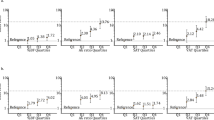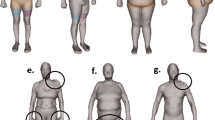Abstract
OBJECTIVE: The main objective was to use a dual-energy X-ray absorptiometer (DXA) to examine the total-body and regional fat and lean composition of soft tissue in subjects with and without eating disorders initially and after weight change. It was necessary also to study the effects of differences of calibration of different models of DXA scanner.
DESIGN: A total of 175 women with eating disorders, including anorexia nervosa (AN) and bulimia nervosa, and 43 age-matched controls were measured for soft-tissue composition with a pencil-beam Hologic QDR 1000W scanner and results converted to be equivalent to those from a fan-beam Hologic QDR 4500A, using previously determined crosscalibration factors. Some measurements were repeated at 6 and 12 months.
RESULTS: The baseline body composition of the patients covered a continuous range of fat proportions. Implausibly low fat proportions in some of the AN subjects were corrected by conversion to 4500 equivalents. The relationship between total lean mass and fat mass could be fitted equally well by a linear or linear/log regression. The relationship between leg and trunk fat was best fitted by a polynomial regression. There were weight changes in either direction in some of the subjects. The fat proportion in the total changed mass was a mean of 55%, higher in the legs and lower in the trunk, but not different between weight gainers and losers or clinical groups. The proportion was dependent on the initial fat proportion.
CONCLUSIONS: Relatively small differences in fat/lean calibration of DXA scanners may lead to anomalous results in very anorexic subjects and corrections are necessary in comparing results from different instruments. Concerns expressed about preferential trunk fat accumulation during weight recovery are not well founded. Previous claims of a relationship between fat proportion in regained weight and the amount of the weight gain are not justified.
This is a preview of subscription content, access via your institution
Access options
Subscribe to this journal
Receive 12 print issues and online access
$259.00 per year
only $21.58 per issue
Buy this article
- Purchase on Springer Link
- Instant access to full article PDF
Prices may be subject to local taxes which are calculated during checkout




Similar content being viewed by others
References
Orphanidou CJ, McCargar LJ, Birmingham CL, Belzberg AS . Changes in body composition and fat distribution after short-term weight gain in patients with anorexia nervosa. Am J Clin Nutr 1997; 65: 1034–1041.
Iketani T, Kiriike N, Nagata T, Yamagami S . Altered body fat distribution after recovery of weight in patients with anorexia nervosa. Int J Eat Disord 1999; 26: 275–282.
Scalfi L, Polito A, Bianchi L, Marra M, Caldara A, Nicolai E, Contaldo F . Body composition changes in patients with anorexia nervosa after complete weight recovery. Eur J Clin Nutr 2002; 56: 15–20.
Grinspoon S, Thomas L, Miller K, Pitts S, Herzog D, Klibanski A . Changes in regional fat distribution and the effects of estrogen during spontaneous weight gain in women with anorexia nervosa. Am J Clin Nutr 2001; 73: 865–869.
Forbes GB . Lean body mass—body fat interrelationships in humans. Nutr Rev 1987; 45: 225–231.
Tothill P, Hannan WJ, Wilkinson S . Comparisons between a pencil beam and two fan beam dual energy X-ray absorptiomers used for measuring total body bone and soft tissue. Br J Radiol 2001; 74: 166–176.
Tothill P, Avenell A, Reid DM . Precision and accuracy of measurements of whole-body bone mineral: comparisons between Hologic, Lunar and Norland dual-energy X-ray absorptiometers. Br J Radiol 1994; 67: 1210–1217.
Tothill P, Avenell A, Love J, Reid DM . Comparisons between Hologic, Lunar and Norland dual-energy X-ray absorptiometers used for whole-body soft tissue measurements. Eur J Clin Nutr 1994; 48: 781–794.
Pritchard JE, Nowson CA, Strauss BJ, Carlson JS, Kaymakci B, Wark JD . Evaluation of dual energy X-ray absorptiometry as a method of measurement of body fat. Eur J Clin Nutr 1993; 47: 216–228.
Van Loan MD, Keim NL, Berg K, Mayclin PL . Evaluation of body composition by dual-energy X-ray absorptiometry and two different software packages. Med Sci Sports Exerc 1995; 27: 587–591.
Patel R, Blake GM, Herd RJM, Fogelman I . The effect of weight change on DXA scans in a 2-year trial of etidronate therapy. Calcif Tissue Int 1997; 61: 693–699.
Prior BM, Cureton KJ, Modlesky C, Evans EM, Sloniger MA, Saunders M, Lewis RD . In vivo validation of whole-body composition estimates from dual-energy X-ray absorptiometry. J Appl Physiol 1997; 83: 623–630.
Visser M, Fuerst T, Lang T, Salamone L, Harris TB . Validity of fan-beam dual-energy X-ray absorptiometry for measuring fat-free mass and leg muscle mass. J Appl Physiol 1999; 87: 1513–1520.
Salamone LM, Fuerst T, Visser M, Kern M, Lang T, Dockrell M, Cauley JA, Nevitt M, Tylavsky F, Lohman TG . Measurement of fat mass using DEXA: a validation study in elderly adults. J Appl Physiol 2000; 89: 345–352.
Tothill P, Hannan WJ, Cowen S, Freeman CP . Anomalies in the measurement of total-body bone mineral by dual-energy X-ray absorptiometry during weight change. J Bone Miner Res 1997; 12: 1908–1921.
Tothill P, Laskey MA, Orphanidou CI . Anomalies in dual-energy absorptiometry measurements of total-body bone mineral during weight change using Lunar, Hologic and Norland instruments. Br J Radiol 1999; 72: 661–669.
Stewart AD, Hannan WJ . Prediction of fat and fat-free mass in male athletes using dual X-ray absorptiometry as the reference method. J Sports Sci 2000; 18: 263–274.
Tylavsky FA, Lohman TG, Dockrell M, Lang T, Schoeller DA, Wan JY, Fuerst T, Cauley JA, Nevitt M, Harris TB . Comparison of the effectiveness of 2 dual-energy X-ray absorptiometers with that of total body water and computed tomography in assessing changes in body composition during weight change. Am J Clin Nutr 2003; 77: 356–363.
Forbes GB . The companionship of fat and lean. In: Ellis KJ, Eastman JD (eds). Human body composition. Plenum Press: New York; 1993. pp 1–15.
Mazess RB, Barden HS, Ohlrich ES . Skeletal and body composition effects of anorexia nervosa. Am J Clin Nutr 1990; 52: 438–441.
Prentice AM, Jebb SA, Goldberg GR, Coward WA, Murgatroid PR, Poppitt SD, Cole TJ . Effects of weight cycling on body composition. Am J Clin Nutr 1992; 56: 209S–216S.
Mayer L . Body composition and anorexia nervosa: does physiology explain psychology? Am J Clin Nutr 2001; 73: 851–852.
Kvist H, Chowdhury B, Grangard U, Tylen U, Sjostrom L . Total and visceral adipose-tissue volumes derived from measurements with computed tomography in adult men and women: predictive equations. Am J Clin Nutr 1988; 48: 1351–1361.
Acknowledgements
We are grateful to Dr CP Freeman for permission to use the data from the eating disorders study, to Dr Rob Elton for statistical advice, to Dr Jane Morris for useful discussions and to Maisie Gard, Karen McPhail, Stephen Cowen and Carol Millar for skilled technical assistance. The eating disorders study was funded by the Scottish Home and Health Department.
Author information
Authors and Affiliations
Corresponding author
Rights and permissions
About this article
Cite this article
Tothill, P., James Hannan, W. Dual-energy X-ray absorptiometry measurements of fat and lean masses in subjects with eating disorders. Int J Obes 28, 912–919 (2004). https://doi.org/10.1038/sj.ijo.0802536
Received:
Revised:
Accepted:
Published:
Issue Date:
DOI: https://doi.org/10.1038/sj.ijo.0802536
Keywords
This article is cited by
-
Body composition by whole-body bioelectrical impedance and prediction of clinically relevant outcomes: overvalued or underused?
European Journal of Clinical Nutrition (2013)
-
Pediatric body composition analysis with dual-energy X-ray absorptiometry
Pediatric Radiology (2009)



